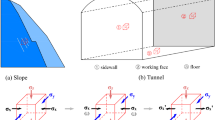Abstract
Rock tensile strength is a factor that affects formation fracturing. Most of the formation fracture pressure prediction models treated it as a constant or ignored it due to its small magnitude. However, the rock tensile strength was observed increasing with elevated crustal stress, so it might be influential at a large depth. In this work, hollow cylinder tensile test method was adopted to measure the tensile strength of two types of sandstones under different confining pressures. Sample in this method has the similar stress state compared with the borehole wall rock, which is important because tensile strength varies with the stress state. The result revealed that there was a significant linear enhancement in rock tensile strength with the increase of confining pressure for both types of sandstones. The effect degree of confining pressure on the tensile strength of two different sandstones was nearly the same.






Similar content being viewed by others
References
Abou-Sayed AS (1978) An experimental technique for measuring the fracture toughness of rock under downhole stress condition. VDI-berichte 313:819–824
Alkan H, Cinar Y, Ülker EB (2010) Impact of capillary pressure, salinity and in situ conditions on CO2 injection into saline aquifers. Transp Porous Media 84:799–819
Anderson TL (2005) Fracture mechanics: fundamentals and applications. CRC press
Anderson RA, Ingram DS, Zanier AM (1973) Determining fracture pressure gradients from well logs. J Pet Technol 25:1–259
Bai B, Li X, Liu M, Shi L, Li Q (2012) A fast explicit finite difference method for determination of wellhead injection pressure. J Cent South Univ 19:3266–3272
Ban S, Anusavice KJ (1990) Influence of test method on failure stress of brittle dental materials. J Dent Res 69:1791–1799
Daines SR (1982) Prediction of fracture pressures for wildcat wells. J Pet Technol 34:863–872
Eaton BA (1969) Fracture gradient prediction and its application in oilfield operations. J Pet Technol 21:1–353
Genter A, Evans K, Cuenot N, Fritsch D, Sanjuan B (2010) Contribution of the exploration of deep crystalline fractured reservoir of Soultz to the knowledge of enhanced geothermal systems (EGS). Compt Rendus Geosci 342:502–516
Holbrook P (1997) Discussion of a new simple method to estimate fracture pressure gradients. SPE Drill Complet 12:71
Hongkui G, Yingsong L, Shanzhou M (2001) Modification of Holbrook’s fracture pressure prediction model. Petroleum Drilling Techniques 29:20–22
Hubbert MK, Willis DG (1957) Mechanics of hydraulic fracturing. US Geol Surv 210:153–168
** Y, Yuan J, Chen M, Chen KP, Lu Y, Wang H (2011) Determination of rock fracture toughness K IIC and its relationship with tensile strength. Rock Mech Rock Eng 44:621–627
Li Q, Lin B, Zhai C (2015) A new technique for preventing and controlling coal and gas outburst hazard with pulse hydraulic fracturing: a case study in Yuwu coal mine, China. Nat Hazards 75:2931–2946. https://doi.org/10.1007/s11069-014-1469-9
Majer EL, Baria R, Stark M, Oates S, Bommer J, Smith B, Asanuma H (2007) Induced seismicity associated with enhanced geothermal systems. Geothermics 36:185–222. https://doi.org/10.1016/j.geothermics.2007.03.003
Maldal T, Tappel IM (2004) CO2 underground storage for Snøhvit gas field development. Energy 29:1403–1411
Matthews WR, Kelly J (1967) How to predict formation pressure and fracture gradient. Oil Gas J 65:92–106
Mighani S, Sondergeld CH, Rai CS et al. (2015) Stress dependency of rock tensile strength. In: 49th US Rock Mechanics/Geomechanics Symposium. American Rock Mechanics Association
Molenda M, Stöckert F, Brenne S, Alber M, et al (2013) Comparison of hydraulic and conventional tensile strength tests. In: ISRM International Conference for Effective and Sustainable Hydraulic Fracturing. International Society for Rock Mechanics
Müller W (1986) Brittle crack growth in rocks. Pure Appl Geophys 124:693–709
Perras MA, Diederichs MS (2014) A review of the tensile strength of rock: concepts and testing. Geotech Geol Eng 32:525–546
Schmidt RA, Huddle CW (1977) Effect of confining pressure on fracture toughness of Indiana limestone. In: International Journal of Rock Mechanics and Mining Sciences & Geomechanics Abstracts. Elsevier, pp 289–293
Thallak S, Holder J, Gray KE (1993) The pressure dependence of apparent hydrofracture toughness. In: International Journal of Rock Mechanics and Mining Sciences & Geomechanics Abstracts. Elsevier, pp 831–835
Wei X, Li Q, Li X, Sun Y (2016) Impact indicators for caprock integrity and induced seismicity in CO2 geosequestration: insights from uncertainty analyses. Nat Hazards 81:1–21. https://doi.org/10.1007/s11069-015-2063-5
Funding
This work was supported by China Postdoctoral Science Foundation (grant numbers 2016M602381).
Author information
Authors and Affiliations
Corresponding author
Additional information
Responsible Editor: Abdullah M. Al-Amri
Rights and permissions
About this article
Cite this article
Li, J., Zhang, G. & Liu, M. Experimental investigation on the effect of confining pressure on the tensile strength of sandstone using hollow cylinder tensile test method. Arab J Geosci 12, 768 (2019). https://doi.org/10.1007/s12517-019-4797-y
Received:
Accepted:
Published:
DOI: https://doi.org/10.1007/s12517-019-4797-y




